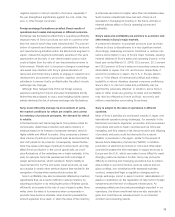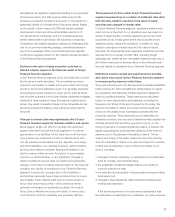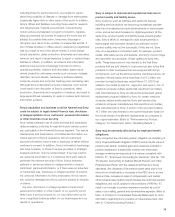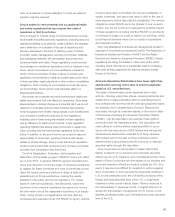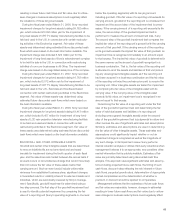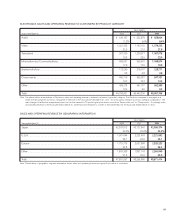Sony 2008 Annual Report Download - page 87
Download and view the complete annual report
Please find page 87 of the 2008 Sony annual report below. You can navigate through the pages in the report by either clicking on the pages listed below, or by using the keyword search tool below to find specific information within the annual report. 85
The Black-Scholes option-pricing model requires various
highly judgmental assumptions including expected stock price
volatility and the expected life of each award. In addition,
judgment is also required to estimate the expected forfeiture rate
and recognize expense only for those rights expected to vest.
Management believes that these estimates are reasonable;
however, if actual results differ significantly from these estimates,
stock-based compensation expense may differ materially in the
future from that recorded in the current period.
■ DEFERRED TAX ASSET VALUATION
Sony records valuation allowances to reduce deferred tax assets
to the amount that management believes is more likely than not
to be realized. In assessing the likelihood of realization, Sony
considers all currently available evidence for future years, both
positive and negative, supplemented by information of historical
results and future earning plans along with tax planning strate-
gies and future reversals of existing taxable temporary differ-
ences for each tax jurisdiction. Sony also considers its ability to
utilize operating loss carryforwards and tax credit carryforwards
prior to expiration in each tax jurisdiction. The estimates and
assumptions used in determining future taxable income are
consistent with those used in Sony’s approved forecasts of
future operations. However, if Sony is unable to generate
sufficient future taxable income in certain jurisdictions, or if there
is a significant change in the actual effective tax rates or the
time period within which the underlying temporary differences
become taxable or deductible, Sony could be required to
reduce the amount of its deferred tax assets or increase its
valuation allowances against its deferred tax assets, resulting in
an increase in its effective tax rate and an adverse impact on
future operating results. Although realization is not assured,
management believes it is more likely than not that all of the
deferred tax assets, less valuation allowance, will be realized.
Although Sony Computer Entertainment Inc. (“SCEI”),
Sony Computer Entertainment America Inc. (“SCEA”) and
Sony Computer Entertainment Europe Limited (“SCEE”) have
recorded cumulative losses in recent years, Sony concluded
that it is more-likely-than-not that SCEI’s, SCEA’s and SCEE’s
deferred tax assets will be fully realized based on the consider-
ation of both positive and negative evidence, including the
Game segment’s projected income from operating activities
and the existence of qualifying tax-planning strategies.
■ FILM ACCOUNTING
An aspect of film accounting that requires the exercise of
judgment relates to the process of estimating the total revenues
to be received throughout a film’s life cycle. Such estimate of a
film’s ultimate revenue is important for two reasons. First, while a
film is being produced and the related costs are being capital-
ized, it is necessary for management to estimate the ultimate
revenue, less additional costs to be incurred, including exploita-
tion costs which are expensed as incurred, in order to determine
whether the value of a film has been impaired and thus requires
an immediate write off of unrecoverable film costs. Second, the
amount of film costs recognized as cost of sales for a given film
as it is exhibited in various markets throughout its life cycle is
based upon the proportion that current period actual revenues
bear to the estimated ultimate total revenues.
Management bases its estimates of ultimate revenue for
each film on several factors including the historical perfor-
mance of similar genre films, the star power of the lead actors
and actresses, the expected number of theaters at which the
film will be released, anticipated performance in the home
entertainment, television and other ancillary markets, and
agreements for future sales. Management updates such
estimates based on the actual results to date for each film.
For example, a film that has resulted in lower than expected
theatrical revenues in its initial weeks of release would
generally have its theatrical, home entertainment and television
distribution ultimate revenues adjusted downward; a failure to do
so would result in the understatement of amortized film costs for
the period.
■ FUTURE INSURANCE POLICY BENEFITS
Liabilities for future insurance policy benefits are established in
amounts adequate to meet the estimated future obligations of
policies in force. These liabilities are computed by the net level
premium method based upon estimates as to future investment
yield, mortality, morbidity, withdrawals and other factors. Future
policy benefits are computed using interest rates ranging from
1.00 percent to 4.90 percent. Mortality, morbidity and with-
drawal assumptions for all policies are based on either the
subsidiary’s own experience or various actuarial tables.
Generally these assumptions are “locked-in” upon the issuance
of new insurance. While management believes that the assump-
tions used are appropriate, differences in actual experience or
changes in assumptions may affect Sony’s future insurance
policy benefits.
■ EQUITY IN NET INCOME OF AFFILIATED COMPANIES
Sony periodically reviews the presentation of its financial
information to ensure that it is consistent with the way
management views the consolidated operations. Since Sony
considers its equity investments to be integral to its opera-
tions, effective for the fiscal year ending March 31, 2009,
Sony will report equity in earnings of affiliated companies
as a component of operating income.


